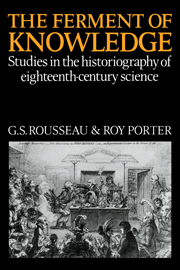Book contents
- Frontmatter
- Contents
- Contributors
- Acknowledgements
- Abbreviations
- Introduction
- PART I PHILOSOPHY AND IDEAS
- PART II LIFE AND ITS ENVIRONMENT
- PART III THE PHYSICAL WORLD
- 8 Mathematics and rational mechanics
- 9 Experimental natural philosophy
- 10 Chemistry and the chemical revolution
- 11 Mathematical cosmography
- 12 Science, technology and industry
- Index
12 - Science, technology and industry
Published online by Cambridge University Press: 03 May 2010
- Frontmatter
- Contents
- Contributors
- Acknowledgements
- Abbreviations
- Introduction
- PART I PHILOSOPHY AND IDEAS
- PART II LIFE AND ITS ENVIRONMENT
- PART III THE PHYSICAL WORLD
- 8 Mathematics and rational mechanics
- 9 Experimental natural philosophy
- 10 Chemistry and the chemical revolution
- 11 Mathematical cosmography
- 12 Science, technology and industry
- Index
Summary
‘We’, wrote a late-eighteenth-century English author, ‘are doing the drudgery by which the Golden Age is to profit’, and, he added, ‘Perhaps some other power may be discovered, as forcible and as manageable as the evaporation from boiling water - another gunpowder that may supersede the present - and other applications of mechanical powers which may make our present wonders sink into vulgar performances’. These forecasts were remarkable, for the first evidently predicts, accurately enough, the wealth and good fortune of nineteenth-century England, while the second foreshadows the characteristic achievements of the twentieth century. And, moreover, they set the eighteenth century in a context; not a golden age, as the writer admitted, for he designated his own time a ‘silver age’, but when compared with the troubled if brilliant seventeenth century a time of consolidation and reasonable, measured progress.
The background
The widespread changes associated with the ‘industrial revolution’ in Britain in the second half of the eighteenth century became apparent William Jackson, The Four Ages (1798), 60, 92. after 1815. Babbage, Dupin, Ure and others toured the industrial areas and reported on the new industries from both the social and the engineering and scientific points of view. Strangely, the economists such as Ricardo and Nassau Senior seem to have been uninterested in the latter, and thus contributed to a culture gap that persisted a long time. From that period onward we can distinguish three separate academic disciplines: the history of technology, economic history and the history of science.
- Type
- Chapter
- Information
- The Ferment of KnowledgeStudies in the Historiography of Eighteenth-Century Science, pp. 449 - 484Publisher: Cambridge University PressPrint publication year: 1980
- 1
- Cited by

